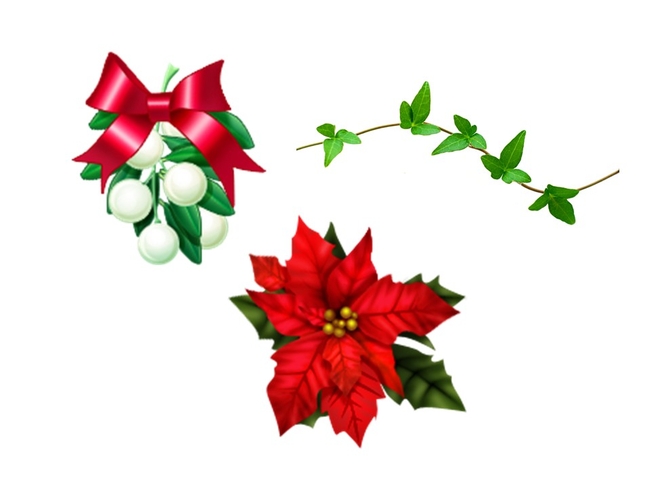It's that time of year again. Time for egg-nog, time for gingerbread cookies, time for stringing outdoor lights that have become tangled up into a massive, intractable knot, and time for decorating the home and hearth with weeds.
What? Weeds?
Yes, weeds. That includes Christmas favorites of mistletoe, ivy, and poinsettia.
Mistletoe (Phoradendrom spp., Arceuthobium spp., Viscum spp.): Mistletoes are evergreen, flowering plants that parasitize other plants to acquire water and nutrients. Mistletoes can, collectively, infest many different species of trees, including: oaks, alders, birches, box elder, zelkova, cottonwood, walnut, some conifers, etc...and are most easily observed after the deciduous trees have lost their leaves. The seeds of many mistletoe species are dispersed by birds who feast on the berries. In fact, the name 'mistletoe' is likely derived from the Anglo-Saxon words 'mistel' (dung) and 'tan' (twig), which appropriately describes the role of birds in the spread of these plants.
Although severe infestations can weaken trees, intensive mistletoe management (by removing infected branches or trees) isn't commonly undertaken unless a sensitive orchard species or historical tree is threatened. Homeowners can slow the growth and development of mistletoe by pruning back live tissue in parasitized trees; where mistletoe is a regular problem, landowners should consider planting species that appear to be resistant, such as crape myrtle, ginkgo, and sycamore. For more information about mistletoe management, visit the UC-IPM website.
Mistletoe has been interwoven into numerous myths, worldwide. Pliny the Elder wrote that mistletoe held on to the life of an oak tree when it went dormant in the winter. Many European ethic groups hung mistletoe around homes and barns to scare away witches and demons, while others thought that it promoted fertility. The tradition of kissing under a mistletoe sprig is also shrouded in legend. In one Norse tale, Frigga's son, Baldr, was killed by an arrow crafted from mistletoe (or else a sword named Mistletoe, depends on your source); following his death, Frigga set forth a declaration that the plant could no longer be made into a weapon and that she would kiss people who walked underneath it, instead. For more information about mistletoe myths see here.
Ivy (Hedera helix): English ivy is a perennial, climbing vine that was introduced to North America by European colonists in the 1700's. Much prized as an easy-to-grow groundcover (it thrives under both sun and shade conditions), it has become a horticultural staple. Unfortunately, English ivy has escaped cultivation and can be found infesting many public and private lands. Despite it's (positive) cultural association with universities (think: ivy vines growing resplendently up red brick walls), the species can be quite a nuisance; the sticky 'glue' on the tendrils can cause unsightly damage to buildings and walls. Ivy can be controlled by repeatedly pruning the vines back to the ground or through the application of systemic herbicides.
Ivy, because of its' clinging nature, has been described as representing the soul's dependence on God; because it is an evergreen, it is also believed to symbolize eternal life. Of course, numerous myths also associate ivy with drunkenness (because it was the symbol of Bacchus and Dionysus, the Roman and Greek gods of wine, respectively), death (because it often grew in cemetaries), and the battle of the sexes (along with holly, another holiday plant).
Poinsettia (Euphorbia pulcherrima): The brilliant and beautiful poinsettia that graces many a house in December is native to Mexico, where it is called the 'flor de la noche buena'. According to a charming (but urban?) legend, Pepita, a poor Mexican child, had nothing to offer in church on the 25th of December but bouquet of scraggly weeds; looking up through her tears, she was stunned to discover that her humble offering had turned crimson on alter. The poinsettia's prominence in modern Christmas celebrations was facilitated by Joel Poinsett (see the connection here?), an ambassador to Mexico, who brought the plant to the United States in the 1820's. Poinsettia is grown, commercially, in CA and the UC IPM website has a pest management guide for the floriculture industry to prevent/control disease in production systems.
The cultivated poinsettia does have an especially weedy cousin, though, that is a problem in some crops, especially peanut and soybean, in the Southern US. Wild poinsettia (Euphorbia heterophylla) is a summer annual that is capable of germinating under extreme conditions (such as pH (2.5-10) and burial depth (up to 6 inches deep)) and can grow up to five feet tall. According to weedscience.org, as of 2014, wild poinsettia has developed resistance to three classes of herbicides: ALS-inhibitors, PSII-inhibitors and PPO-inhibitors, with all of the biotypes occurring in South America.
Happy Holidays.
Figure 1. Who are you calling a weed? Me? Are you talking to me?
